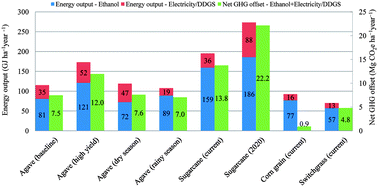Life cycle energy and greenhouse gas analysis for agave-derived bioethanol
Abstract
The sustainability of large-scale biofuel production has recently been called into question in view of mounting concerns over the associated impact on land and

* Corresponding authors
a
Low Carbon Mobility Centre, Smith School of Enterprise and the Environment, University of Oxford, Hayes House, 75 George Street, Oxford, UK
E-mail:
xiaoyu.yan@alumni.qmul.net, oliver.inderwildi@smithschool.ox.ac.uk, director@smithschool.ox.ac.uk
Tel: +44 (0)1865 614915
b
Department of Plant Sciences, University of Oxford, South Parks Road, Oxford, UK
E-mail:
andrew.smith@plants.ox.ac.uk
Fax: +44 (0)1865 275074
Tel: +44 (0)1865 275009
c
Faculty of Agriculture Food and Natural Resources, The University of Sydney, Sydney, Australia
E-mail:
daniel.tan@sydney.edu.au
Fax: +61 2 8627 1099
Tel: +61 2 8627 1052
The sustainability of large-scale biofuel production has recently been called into question in view of mounting concerns over the associated impact on land and

 Please wait while we load your content...
Something went wrong. Try again?
Please wait while we load your content...
Something went wrong. Try again?
X. Yan, D. K. Y. Tan, O. R. Inderwildi, J. A. C. Smith and D. A. King, Energy Environ. Sci., 2011, 4, 3110 DOI: 10.1039/C1EE01107C
To request permission to reproduce material from this article, please go to the Copyright Clearance Center request page.
If you are an author contributing to an RSC publication, you do not need to request permission provided correct acknowledgement is given.
If you are the author of this article, you do not need to request permission to reproduce figures and diagrams provided correct acknowledgement is given. If you want to reproduce the whole article in a third-party publication (excluding your thesis/dissertation for which permission is not required) please go to the Copyright Clearance Center request page.
Read more about how to correctly acknowledge RSC content.
 Fetching data from CrossRef.
Fetching data from CrossRef.
This may take some time to load.
Loading related content
